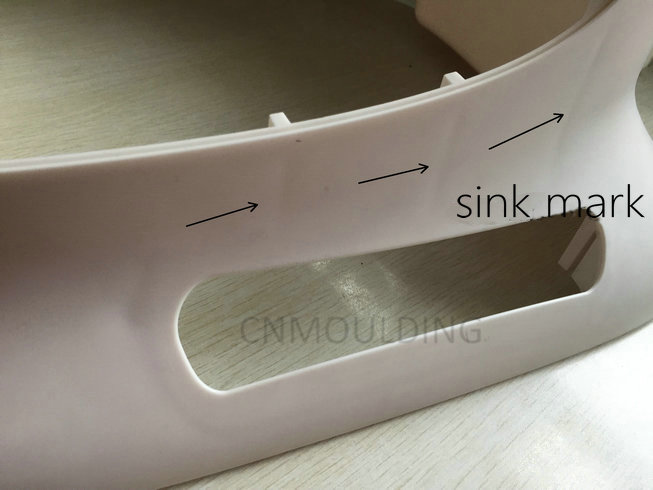The reasons for sink mark in plastic products are as follows:

Reasons for injection molding sink mark
Sink marks in injection molding are common defects that occur when the surface of a molded part shrinks and creates a depression or dimple. This typically happens because the inner part of the material cools and shrinks faster than the outer surface, pulling the surface inward. Sink marks are most noticeable on thicker sections of the part or near ribs, bosses, or other features that create variations in wall thickness.
Causes of Sink Marks:
- Insufficient Cooling Time:
- If the cooling time is too short, the outer surface solidifies while the inner material is still cooling and shrinking, causing sink marks.
- Inadequate Holding Pressure or Time:
- Holding pressure helps pack additional material into the mold to compensate for shrinkage. If the pressure or time is insufficient, the material shrinks excessively, leading to sink marks.
- Excessive Wall Thickness:
- Thicker sections cool more slowly, increasing the likelihood of shrinkage and sink marks.
- High Material Shrinkage Rate:
- Some materials, such as semi-crystalline plastics (e.g., polypropylene or nylon), have higher shrinkage rates, making them more prone to sink marks.
- Improper Gate Location or Size:
- If the gate is too small or poorly located, it can restrict the flow of material, preventing adequate packing and leading to sink marks.
- High Melt Temperature:
- Excessive melt temperature can increase material shrinkage as it cools, contributing to sink marks.
How to Prevent Sink Marks:
- Optimize Wall Thickness:
- Design parts with uniform wall thickness to ensure even cooling. If thick sections are unavoidable, use coring or ribbing to reduce material volume.
- Increase Holding Pressure and Time:
- Apply sufficient holding pressure and extend the holding time to pack more material into the mold and compensate for shrinkage.
- Adjust Cooling Time:
- Ensure adequate cooling time to allow the entire part to solidify uniformly.
- Use Low-Shrinkage Materials:
- Select materials with lower shrinkage rates, such as amorphous plastics (e.g., ABS, PC) or filled resins.
- Optimize Gate Design:
- Use larger gates or position them near thicker sections to ensure proper material flow and packing.
- Control Melt Temperature:
- Avoid excessively high melt temperatures to minimize shrinkage.
- Add Mold Features:
- Incorporate mold features like gas vents or cooling channels to improve cooling efficiency and reduce shrinkage.
Corrective Actions for Existing Sink Marks:
- Increase holding pressure and time.
- Reduce melt temperature.
- Extend cooling time.
- Modify part design to reduce wall thickness or add coring.
- Adjust gate size or location.
By addressing these factors, you can minimize or eliminate sink marks and improve the quality of injection-molded parts.







